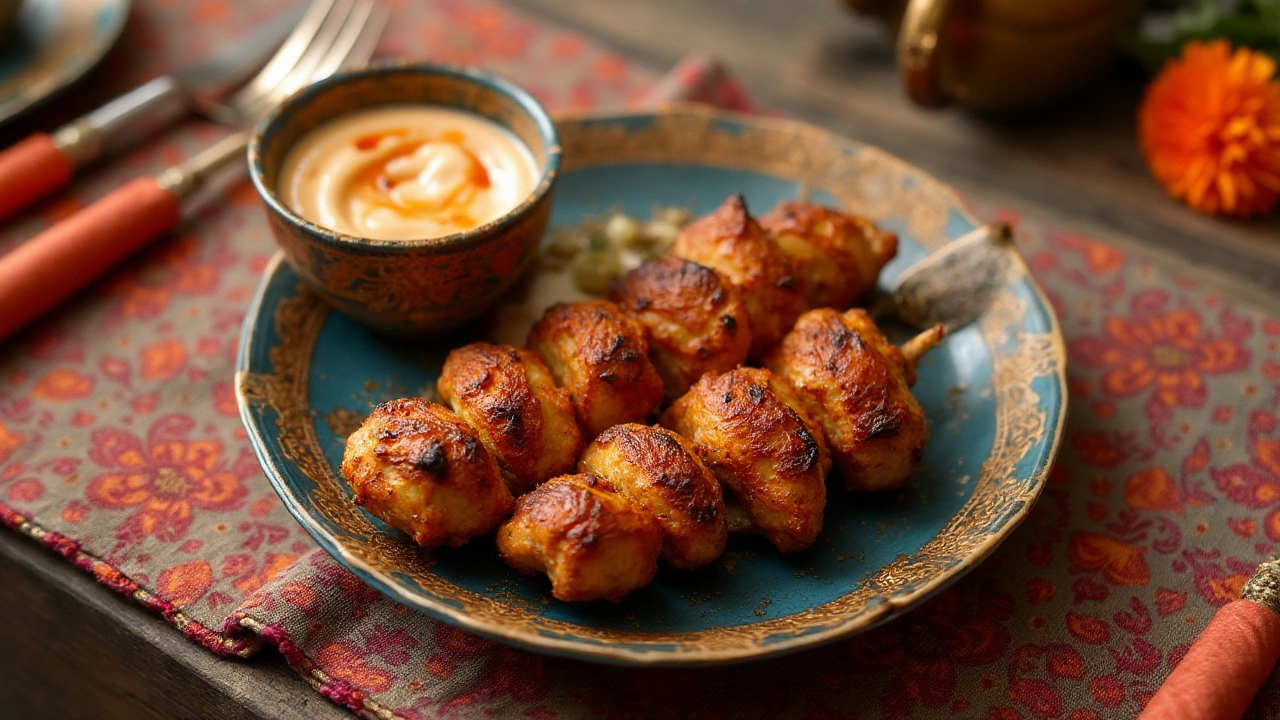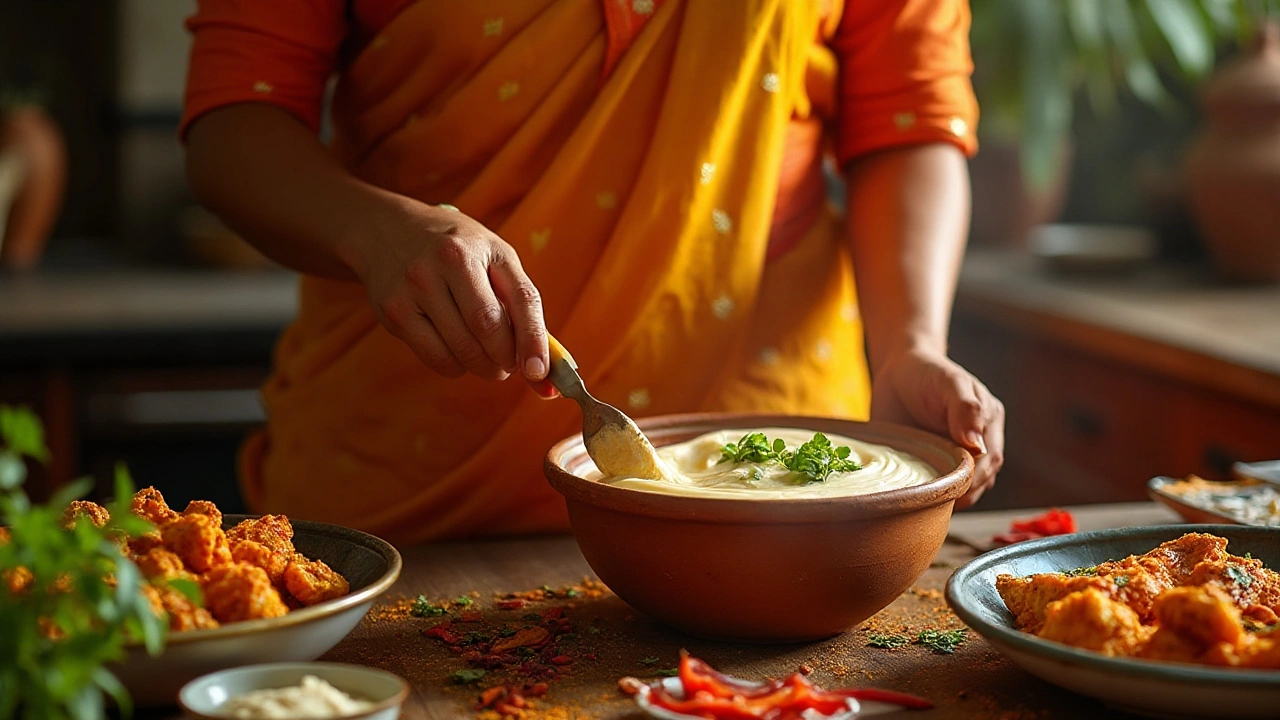11 Dec 2024
- 0 Comments
Imagine merging the rich, aromatic spices of tandoori with the comforting, creamy texture of mayonnaise. Sounds intriguing, doesn't it? Tandoori mayonnaise is an exciting culinary fusion that has been making waves among food enthusiasts, especially those who adore a hearty twist to their classic chicken recipes. This imaginative blend takes the essence of tandoori flavors—such as earthy cumin, tangy coriander, and a touch of fiery pepper—and swirls it into the velvety smoothness of mayonnaise. The result is a vibrant, zingy concoction that can revitalize your meals in unexpected ways.
Whether you're hosting a casual get-together or simply craving something extraordinary for dinner, tandoori mayonnaise can transform the pedestrian into the spectacular. Its versatility ranges from being a marinade powerhouse for chicken to a zesty dip for fries, adding that extra oomph wherever needed. But how exactly do you master the art of making and using this modern marvel? Don't worry—this guide is here to enlighten your path to a more flavorful kitchen exploration.
- The Origin and Essence of Tandoori Mayonnaise
- How to Make Homemade Tandoori Mayonnaise
- Tips for Perfectly Pairing Tandoori Mayonnaise with Dishes
- Creative Uses Beyond Tandoori Chicken
- Health Considerations and Customizing Spice Levels
The Origin and Essence of Tandoori Mayonnaise
The rich tapestry of Indian culinary tradition meets global tastes in the remarkable invention of tandoori mayonnaise. To truly appreciate this blend, it's vital to delve into its components. The word "tandoori" immediately conjures images of aromatic spices and meat grilled to perfection in a tandoor, an open-sided clay oven native to India's northern regions. This cooking method, dating back over 5,000 years, is cherished for imparting a smoky flavor and unique texture, beloved by many around the world. The idea of combining this traditional cuisine with mayonnaise, a product of France's culinary masterpiece of emulsification dating back to the 18th century, is nothing short of a cultural romance, symbolizing how food transcends borders to create something truly special.
Strong advocates for this fusion recall the evolution of tandoori chicken itself, once a dish fit only for royal tables, but now enjoyed globally. This transformation is reminiscent of how tandoori mayonnaise has made its way into mainstream kitchen shelves and restaurants, showcasing how Indian flavors have harmonized with an international pantry staple. The emphasis on flavor has always been paramount in Indian cuisine, where spices play a pivotal role in crafting the overall sensory experience. Tandoori mayonnaise relies on the same principles, balancing the tangy, spicy notes typical of tandoori chicken marinades with the creamy, hearty base of mayonnaise. It's a dance of flavors that highlights both traditions without losing the identity of either.
Adopting this mixture into everyday meals doesn't just broaden the taste palette but also offers culinary flexibility—a trait cherished by modern chefs and home cooks alike. Setting the tone for adaptation, the creation of tandoori mayonnaise isn't just about mixing ingredients; it's about forging connections between different parts of the world. A fusion born out of necessity and innovation, where a craving for something familiar yet exciting can lead to novel gastronomic experiences.
Food historian, K.T. Achaya, once said, "The history of food is the history of the world," emphasizing how ingredients and methods evolve to meet new cultural waves.By introducing tandoori mayonnaise into various cuisines, it allows traditional flavors to speak new languages, resonating with a different audience and inviting them to explore the rich, flavorful world of Indian cuisine.
How to Make Homemade Tandoori Mayonnaise
Creating homemade tandoori mayonnaise is a simple yet rewarding culinary adventure that brings a contemporary twist to traditional Indian flavors. If you've ever marveled at the symphony of spices in tandoori chicken, then this twist will captivate your taste buds. Begin by gathering fresh ingredients to ensure a robust taste experience. Start with a base of high-quality mayonnaise, preferably one with a neutral flavor that allows the spices to shine. To this, add a harmonious mix of classic tandoori spices: cumin, coriander, garam masala, smoked paprika, and a pinch of cayenne pepper for that characteristic warmth. Each spice plays a pivotal role, with cumin providing earthiness and coriander offering a hint of citrus that brightens the palate.
When blending these spices into the mayonnaise, consider the proportions—aim for balance without overwhelming the creamy base. A typical ratio might be one tablespoon of each spice per cup of mayo, but this can be adjusted to suit your personal taste preference. Don't shy away from adding a fresh squeeze of lime juice, which not only enhances the tang but also helps in emulsifying the spices into the mayo seamlessly. Another secret ingredient is garlic powder, which adds a subtle depth, reminiscent of the complex flavors in Indian cuisine. And let's not forget ginger powder; its zingy undertone elevates the taste to new heights.
"The key to a successful tandoori marinade, much like in our tandoori mayonnaise, lies in the perfect spice blend," says culinary expert and chef Anjali Pathak.For those who love experimenting, you can introduce a dollop of yogurt to the mix, mimicking the traditional yogurt marinade used in many Indian dishes. This not only maintains authenticity but adds a slight tartness that contrasts beautifully with the sweetness of the mayonnaise. For mixing, a whisk is your best friend, ensuring that every hue and aroma fuse together flawlessly. Once blended, let it rest in the refrigerator for a few hours. This resting period allows the flavors to meld and intensify, resulting in a mayonnaise that is not only aromatic but packed with a burst of flavors every time you dip or spread. Serve it with grilled chicken, vegetables, or simply as a dip for snacks—you'll find its uses are as versatile as the spices it's made from.

Tips for Perfectly Pairing Tandoori Mayonnaise with Dishes
Matching the delightful fusion of tandoori mayonnaise with the right dishes can truly elevate your culinary experience. Imagine biting into a toasted sandwich with layers of grilled vegetables, where the creamy spread with its tandoori zest gently wraps around each ingredient, enhancing their flavors while adding a tantalizing spice kick. The key to using tandoori mayonnaise effectively lies in understanding its character—a harmony of tanginess, creaminess, and spice. This knowledge allows you to choose foods that complement these elements without overpowering them.
A fantastic beginning is to use tandoori mayonnaise as a marinade for proteins like chicken or fish. The spices in the mayonnaise seep deep into the meat, delivering an amplified taste that regular marinades might lack. After marinating, grilling or baking the meat will create a delightful crust that locks in moisture, making each bite juicy and flavorful. Another brilliant idea is to incorporate it into your fast-food favorites. Smear it generously on burger buns, allowing it to melt slightly onto hot, juicy patties, giving you a burst of Indian-inspired flavors in a classic American dish.
For festive occasions, consider tandoori mayonnaise as an intriguing dip for appetizers such as kebabs or even vegetarian fritters like zucchini bites or potato croquettes. Its versatility lies in how it adapts to different textures and flavors, whether crispy or soft. This condiment pairs surprisingly well with salads, too, especially ones involving lentils or chickpeas—the rich earthy notes of pulses make a delightful play on the palate against the creamy, spicy dressing.
Exploring creative uses can extend beyond traditional meals. You might try using tandoori mayonnaise as a base for coleslaw, adding a new dimension to the classic side dish. Its spices balance beautifully against the sweetness of shredded carrots and the crunch of cabbage. For an unconventional twist, mix it with boiled potatoes and fresh herbs, crafting an exceptional potato salad that's both familiar and novel. Those who love to bake might even indulge in using it as a filling for savory pastries or pinwheels; the possibilities are limitless.
Notably, many chefs appreciate how it brings regional flavors to international dishes. Consider a quote from culinary commentator and food historian, Marina Raben:
"The beauty of tandoori mayonnaise is its capacity to bridge cultures—its spice whispers Indian tradition, while its creamy nature opens up to the world."This global adaptability makes it an essential component for any adventurous cook eager to experiment across the culinary spectrum.
Creative Uses Beyond Tandoori Chicken
While tandoori chicken might be the first dish that comes to mind when thinking of tandoori mayonnaise, its utility stretches far beyond just marinating and enhancing poultry. This captivating condiment can invigorate a plethora of dishes, making it a true kitchen essential. For vegans and vegetarians, try drizzling it over roasted vegetable salads. Its spicy creaminess pairs beautifully with charred broccoli, roasted sweet potatoes, or grilled cauliflower. The blend of flavors creates a harmonious dish that is both satisfying and full of character. For those who enjoy savory breakfasts, this condiment can revolutionize your brunch game by serving as a spread for sandwiches or a zesty component on avocado toast—the earthiness of the spices complements the fresh taste of avocados perfectly.
Another spectacular use is within wraps and rolls. Whether you're preparing an elaborate chicken tikka roll or a simple vegetable wrap, adding a dollop of homemade tandoori mayonnaise can transform it into an exotic delight. For instance, a traditional falafel wrap can take on an Indian twist with this fusion mayonnaise, providing a refreshing change from the usual tahini or yogurt sauce. It's not just a finishing sauce either. Mix it directly into fillings like shredded chicken or paneer to add an infused depth of flavor that tantalizes taste buds with each bite. Cheese lovers will be thrilled to find it acts as a unique dipping sauce for cheese platters, accentuating the flavors of both mild and strong cheeses.
Pizza is another canvas where tandoori mayonnaise shines. Drizzle it over a freshly baked pizza to add a spicy kick that echoes the sensation of a well-crafted spice mix. Even better, use it as a base sauce on naan bread, topped with your favorite toppings for a quick and vibrant meal. Pair it with some olives, roasted bell peppers, and onions for a sensational Indian-Mediterranean fusion. Don't underestimate it as a sidekick in your snack pantry either. Serve it as a dip alongside a plate of samosas or pakoras at a social gathering, and watch how quickly it becomes the star of the show. Surprisingly, jalapeno poppers taste extraordinary when dipped in this rich concoction, elevating them to a gourmet level.
In the world of sandwiches and burgers, replacing your usual spread with tandoori mayonnaise can invigorate even the simplest recipes. Imagine the tangy and spicy flavor infusion on a classic burger; the experience is both exciting and delightful. For vegetarians, portobello mushroom burgers or grilled halloumi cheese sandwiches soak up this flavorful mayonnaise like a dream, offering an adventure for the palate. It's impressive how it enhances global cuisines by complementing Asian, Mediterranean, and even classic American styles seamlessly. Why not experiment by creating your own fusion recipes? Culinary creativity is the boundary.
Interestingly, if you're into Barbecue and grilling, this mayonnaise becomes a remarkable basting agent. Use it to brush over your favorite grilled items just before serving. It infuses them with a smoky Javanese style of flavoring, like nothing else. It's interesting to note that according to a culinary survey, fusion condiments like tandoori mayonnaise are reported to see a year-on-year growth in popularity by nearly 15% among top urban dining spots globally. This suggests that its demand is steadily increasing, taking root in diverse culinary traditions around the world. And for those with a sweet tooth, don't rule it out as a unique topping for savory snacks that include a touch of sweetness, giving it that balance many cravers desire.

Health Considerations and Customizing Spice Levels
When indulging in the delightful combination found in tandoori mayonnaise, it's essential to be mindful of the health aspects, particularly if you or someone you're serving has dietary restrictions or health goals. One of the primary health considerations lies within the base of mayonnaise itself, which traditionally consists of eggs, oil, and sometimes sugar and preservatives. Those watching their cholesterol or calorie intake might find it wise to opt for lighter versions like low-fat or vegan mayonnaise when crafting their own tandoori mayonnaise. Such alternatives can lessen the calorie load while still allowing you to savor the creamy essence that complements the tandoori chicken so well.
Beyond the mayonnaise base, the spices used in tandoori mix also carry health implications. The traditional blend includes cumin, coriander, turmeric, and cayenne, each of which brings distinct benefits to the table. Turmeric is renowned for its anti-inflammatory properties, and cumin is often praised for aiding digestion. Family dinners might benefit from these spices, particularly for guests sensitive to rich foods. Adjusting the spice levels can be both an art and a necessity, especially considering that cayenne can bring considerable heat that some may find overwhelming. This balance of flavors and spiciness is crucial for making the dish accessible to all taste buds. As celebrity chef Sanjeev Kapoor aptly puts it, "A dish is only perfect when it speaks to all its diners."
Customizing spice levels in tandoori mayonnaise can be done thoughtfully by gradually incorporating spices, allowing for taste tests along the way. A simple method is to start mild and slowly introduce more heat, which helps in avoiding an accidental spice bomb. For families with diverse palates, consider making two batches: one with a restrained hand on the chili and another with a more adventurous spice palette. It's also useful to note that many store-bought tandoori spice blends vary significantly in heat. Thus, always scrutinize labels and try smaller amounts before committing to your mix. To aid in balance, a sprinkle of sugar or a dash of mustard could soften the heat without disturbing the overall flavor profile. For those more inclined, adventurous additions like smoked paprika or even powdered fenugreek can introduce new notes and complexity.
A neat trick for those worried about drying out their chicken when using tandoori chicken recipes with mayonnaise is a brief immersion. By marinating the chicken in the tandoori mayonnaise mixture briefly, the surface can absorb flavor without acting as a drying agent during grilling, ultimately maintaining a juicy interior. This dual role of the mayonnaise as both spice medium and moisture keeper is an endeavor worth mastering. For strict vegetarians, tandoori mayonnaise can be beautifully slathered on paneer or vegetables before roasting, offering a hearty, spicy alternative. Adjusting spice also means considering the meal's audience—children may prefer milder versions, while spice aficionados can reach for additional chili powder under adult supervision.
